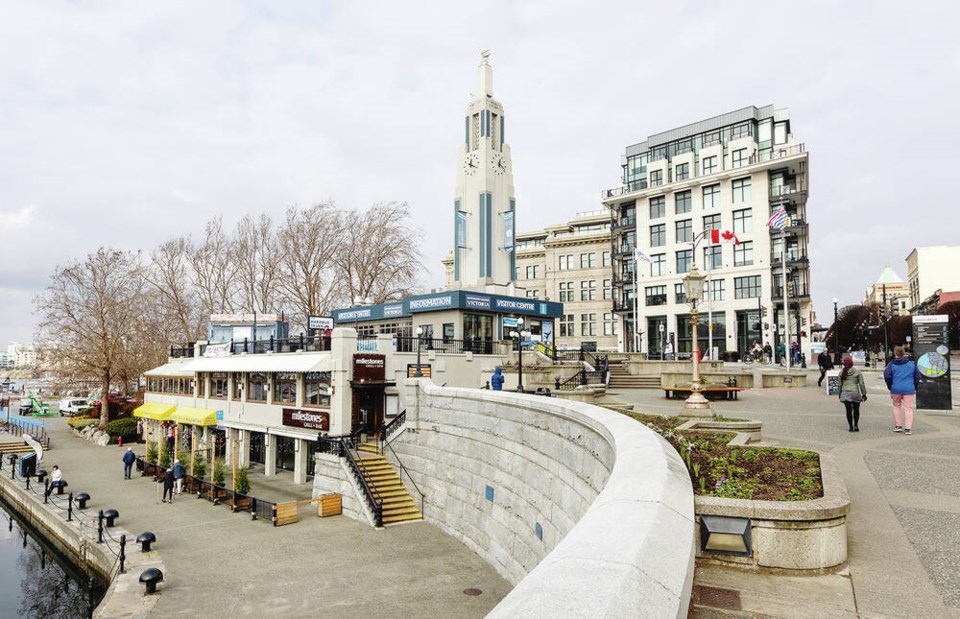Hotel room rates are up, meetings and conferences are bouncing back and could surpass pre-pandemic levels, and at least five new hotels are in the works in the region.
It’s spurring optimism for Greater Victoria’s tourism industry as it rebounds from the pandemic, but some in the sector caution that a tight labour market, increased costs, B.C. Ferries disruptions and events such as wildfires could reduce the number of visitors.
Paul Nursey, chief executive of Destination Greater Victoria — which unveiled its 2024 business plan at the Victoria Conference Centre on Wednesday — said tourism is operating in a “complex landscape,” where everything from interest rates to inflation and global events can have an influence.
Nursey urged members to stay the course on initiatives supporting the sector, pointing to bright spots such as October’s announcement that the Belleville Terminal, where the Coho and Clipper ferries to the U.S. dock, will be redeveloped.
“If we keep making good moves now, it will help us all for the future.”
For example, he said, Destination Greater Victoria worked for a couple of years to attract Samantha Brown, host of the show Places to Love. Her segment on Victoria will air on PBS through this year.
Other bright spots include Greater Victoria winning several accolades from high-profile tourism publications. Last fall, Victoria was named the best small metropolis in Conde Nast Traveler’s annual readers’ choice awards, while Vancouver Island was deemed the fourth-best island in North America. A total of 520,000 readers voted.
Meanwhile, the plan notes that the average daily hotel room rate was up 27 per cent last year from pre-pandemic 2019.
Meetings and conferences have been key drivers in the recovery of Greater Victoria’s visitor economy, the business plan says.
Destination Greater Victoria is keen to attract more airlines to the region, with partnerships that involve shared marketing.
This year, the organization will continue focusing on travellers such as “nested independents” — defined as those 55 and older with flexible schedules and discretionary income who participate in a range of activities, including cultural experiences, and are interested in longer stays.
Another target group dubbed “coastal culturalists” are defined as millennials and couples who put a high value on local experiences and food. They often travel during off-peak times to get the most value for their money.
The “young with the restless” are parents travelling with children. They plan itineraries and experiences that put their children first, and their disposable income ranges from moderate to high.
It’s important to offer key visitor groups experiences that connect with them emotionally, said Jody Westbury, Destination Greater Victoria’s vice-president of marketing and communication.
Westbury said the organization will continue focusing on key markets in Vancouver and the Lower Mainland, Calgary, Greater Toronto, Seattle and the San Francisco area.
It’s investigating whether it wants to put resources into attracting visitors from Edmonton and Portland, Oregon.
Planned marketing efforts include increasing Destination Greater Victoria’s social-media following, using local influencers and upgrades to its website.
Sports tourism has become an important component of the local visitor sector. A report is underway on the impact of Scotiabank Hockey Day in Canada: Victoria Hockey Day, which ran from Jan. 11 to 20 and brought thousands of people to the city.
This year will see Destination Greater Victoria look at marketing partnerships with a variety of transportation providers to share investment costs, such as with the FRS Clipper and the Black Ball Ferry Line’s MV Coho.
The plan notes that transportation is critical to Greater Victoria because of its island location.
“Unlike other destinations that are not located on an island, a disruption to any mode of transportation can have an immediate and widespread ripple effect within the visitor economy.”
Destination Greater Victoria’s plan also emphasizes sustainable tourism, which it says is “not only good business practice but also directly aligned with community values.”
It plans to maintain and extend its international biosphere certification, showing its commitments to 17 sustainable development goals.
>>> To comment on this article, write a letter to the editor: [email protected]



